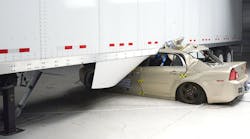Underride guards on the sides of semi-trailers rather than aero side skirts can effectively prevent decapitation and other roof-shear/ crush injuries in a T-bone-type side collision with a passenger car, a new study has found.
In the study released today, the Insurance Institute for Highway Safety (IIHS) ran two tests crashing a passenger sedan at 35 mph into the side of a 53-ft. dry van trailer. In one test, the trailer had an AngelWing side underride protection device, which on the surface looks similar to an aerodynamic skirt but has strong reinforcing beneath.
The passenger car in that test hit the side of the trailer but struck and was repelled as in a normal collision. The car's airbags and seat belts did what they're designed to do and restrained and protected the test dummies from the collision force.
In the second test, the passenger car hit the side of the trailer and kept going, shearing off part of its roof and wedging the car beneath the trailer. "In a real-world crash like this, any occupants in the car would likely sustain fatal injuries," the study authors concluded.
Installing underride guards like the AngelWing device made by AirFlow Deflector is an important safety upgrade for truck trailers, they advised, since nearly one out of five passenger vehicle occupants killed in two-vehicle collisions with heavy trucks died because the car went under the trailer in these kinds of roof-shear/ wedged-underneath wrecks.
AngelWing underride guard vs. aero side skirt
That roughly 20% portion of side-collision-related passenger car occupant deaths has been consistent going back more than a decade, and likely has been the case for much longer.
Data from heavy truck-passenger car crashes over the 2005-2015 period indicate that with the exceptions of 2008 and 2011, side impacts caused between 20-24% of passenger vehicle occupant fatalities. Under-trailer side impacts were responsible for 19% of passenger car occupant deaths in 2008 and 18% in 2011 (see chart).
Meanwhile, passenger car occupant fatalities from rear-end collisions into a truck trailer accounted for fewer deaths across the board, although fatalities from those types of collisions have been approaching closer parity with trailer side impact-related deaths.




